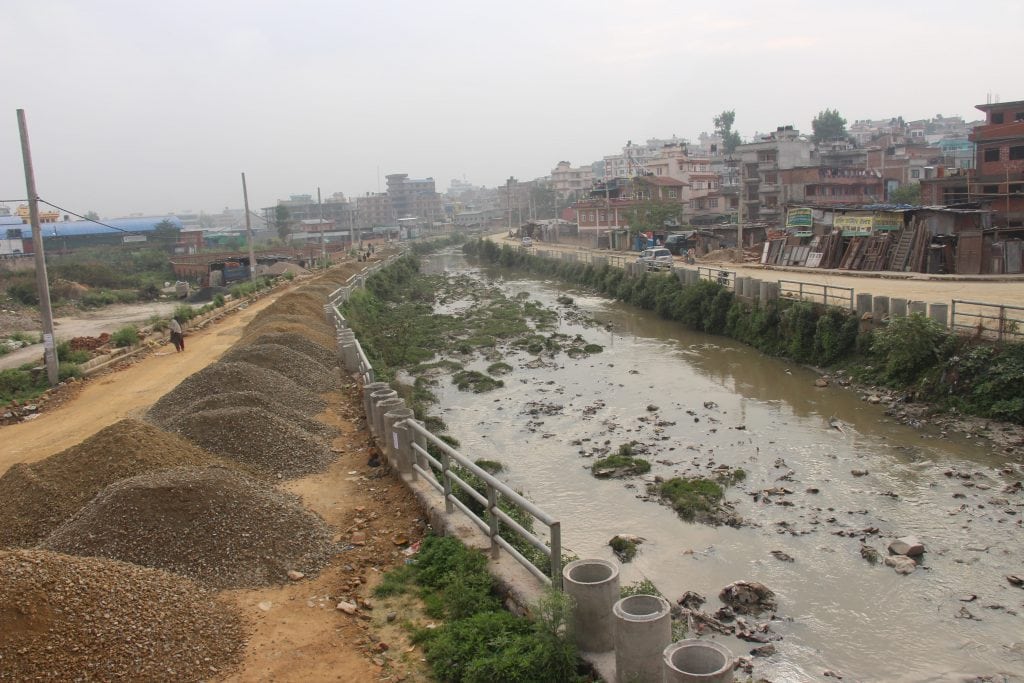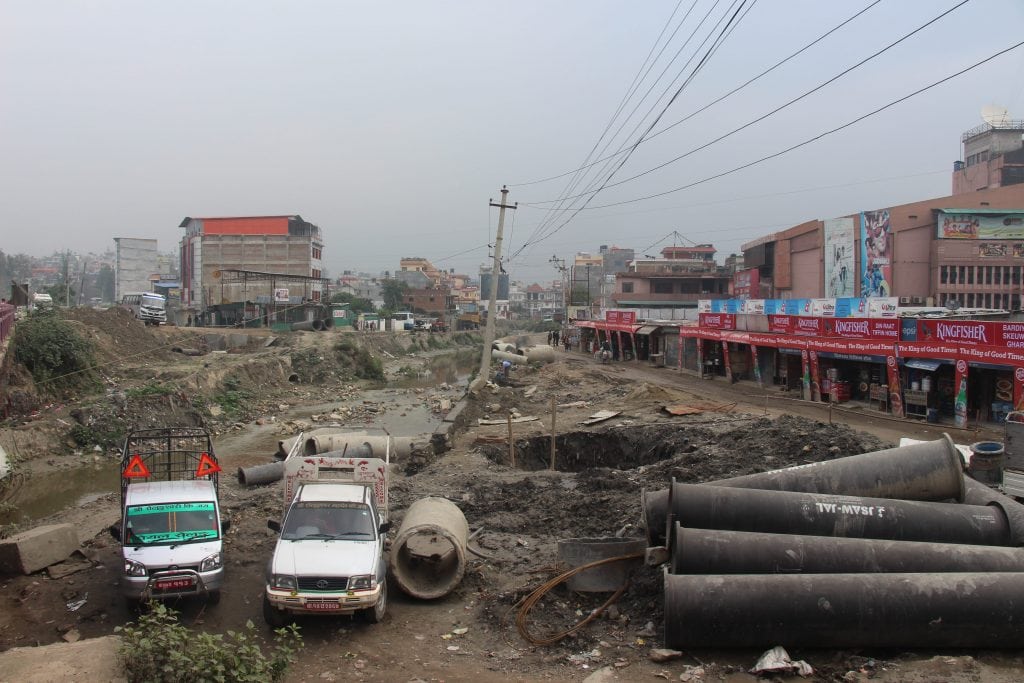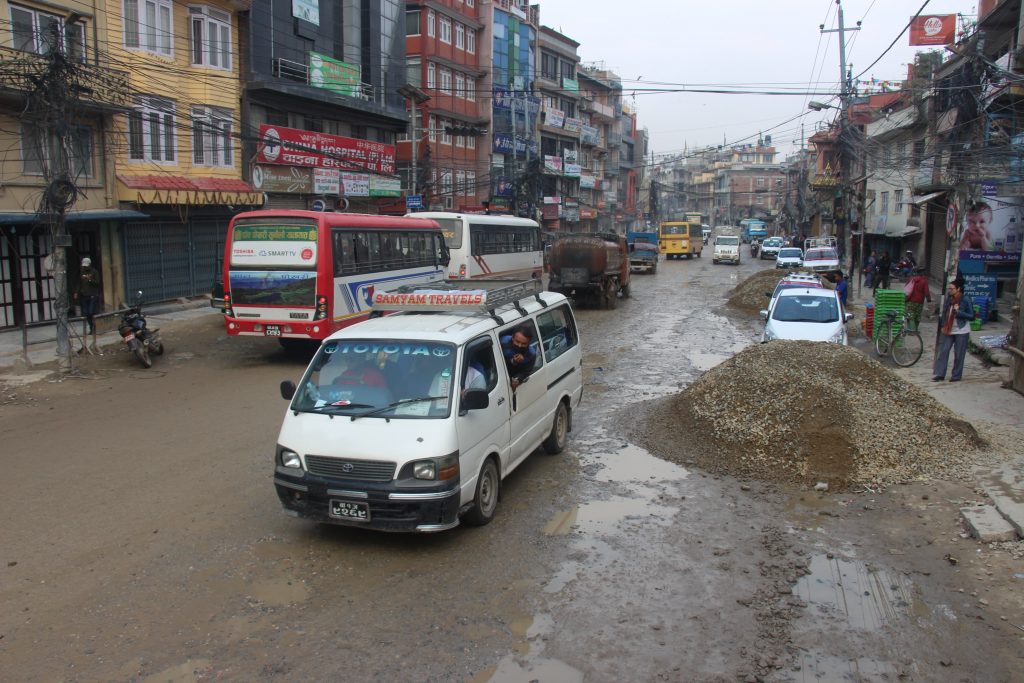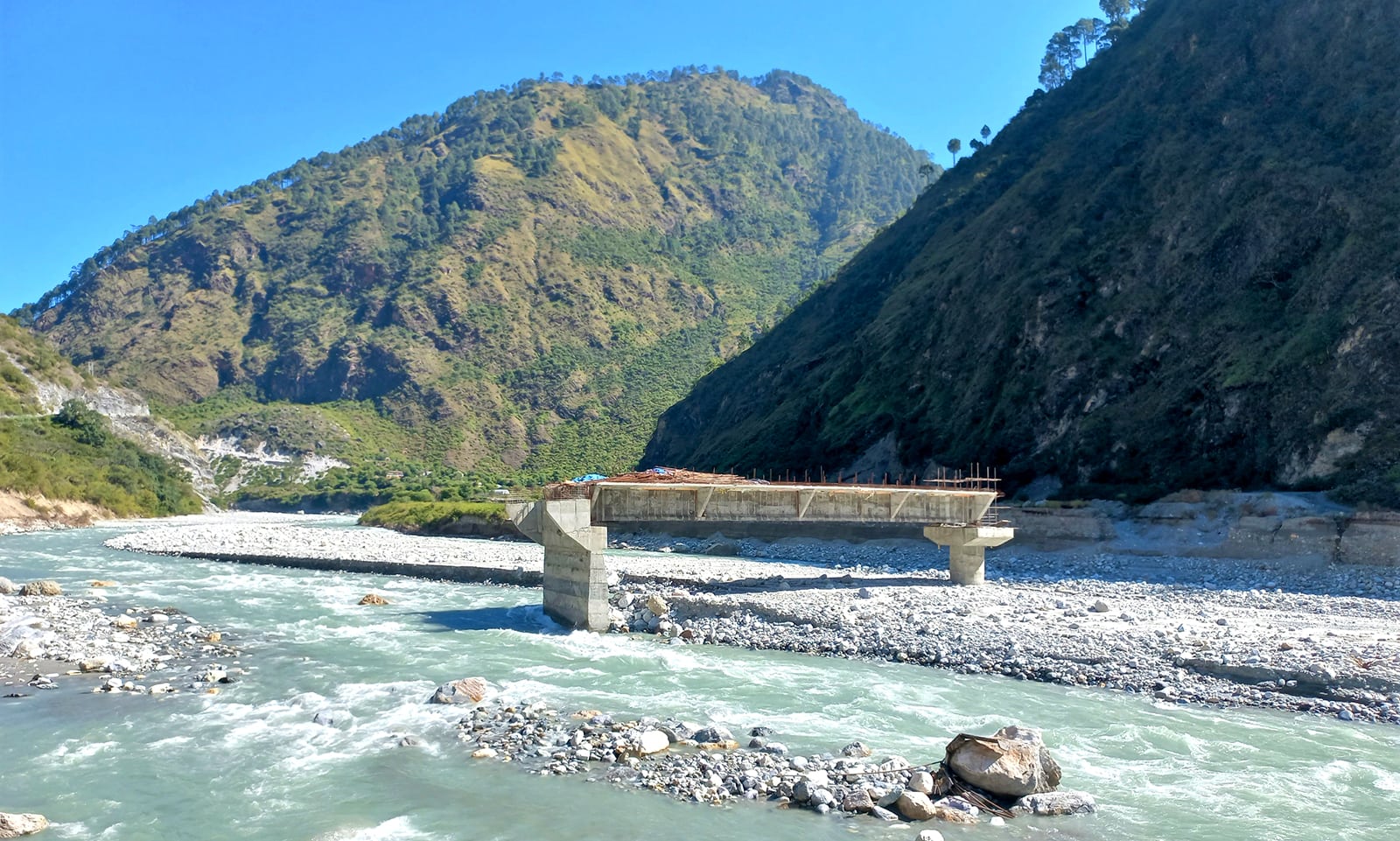The Dhobikhola Corridor in Kathmandu is ‘being constructed’ for the last 16 years. The construction of the Chabahil-Jorpati-Sankhu road is ‘under construction’ for the last 30 years. Works move at a snail’s pace, yet the concerned authorities seem to be least bothered. Contracts are made haphazardly.
Himal Lamsal/Khilak Budhathoki : Centre for Investigative Journalism-Nepal
Thirty-six years ago in 1982, when Ram Prasad Shrestha came to Kathmandu from Nawalparasi, the Dhobikhola corridor was swathed with bushes. He now reminiscences those days when the Dhobikhola water occasionally inundated the human settlements.
Almost 12 years after he joined the civil service as an overseer, the government conceived a project of constructing roads at both the sides of Dhobikhola corridor. It’s been two years now that Shrestha retired as the chief engineer of the project. Yet the project is in limbo.

Dhobikhola Corridor in between the Bhatkeko Pul and Kalopul.
Dhobikhola Corridor is one among several projects in the Kathmandu Valley, which continues to be in shambles with authorities watching as mute spectators. The Chabahil-Chuchepati-Sankhu road envisioned by the Kathmandu Valley Urban Development Committee some three decades ago on Kartik 18, 2045 is another example of sheer negligence. The committee announced the endeavor by publishing a notice in the Gorkhapatra daily the same year. Unfortunately, the project remains incomplete in 2018.
The projects – failing to achieve milestones for the last 27 years on various pretexts — were expedited in 2072. The Kathmandu Valley Road Improvement Project on Asoj 2072 allocated contracts to different companies in its endeavor to widen the roads adhering to the criteria set by the Urban Development Committee in 2045. The deal was made to widen the roads by 11 meters on both sides from the center of the road. Regrettably, despite the agreement to complete the entire undertaking by Chaitra 2074, barely 26 percent of the overall work has been finished so far.
In order to find out the reason behind the delay, we approached Kishore Thapa, former Secretary at the Urban Development Ministry, who candidly went on to say this: “It’s all about the commission. Government officials get some share as ‘commission’ money from the contractor right away after signing an agreement. Moreover, the ministers are accustomed to inaugurating such development projects merely for a publicity stunt.” Thapa said that the projects have been suffering significant delays due to the slapdash and haphazard agreements with the contractors.
The saga of the Dhobikhola Project
The commencement of the Dhobikhola project and the increase in the population of the Kathmandu Valley has been simultaneous. At the same time, the Kathmandu Valley saw a significant increase in vehicles. The 27-kilometer ‘wide’ Ring Road began to witness traffic congestion. Considering the flow of traffic, the government conceived the Dhobikhola corridor project to ease the traffic congestion in the Kathmandu Valley and to manage the settlement.

Scene of the Bhatkeko Pul and Om Hospital at the Dhobikhola Corridor.
Earlier in 1993, the Japan International Cooperation Agency (JICA) had submitted a report to the government about the ‘Dhobikhola Corridor’ upgrading project by developing inner roads to manage the traffic and to contribute in the urban development. With the government’s concurrence to the report, the Kathmandu Valley Urban Development Committee formed the Dhobikhola Corridor Improvement Project Management Sub-committee entrusting the Kathmandu Metropolitan City (KMC) to construct the “Dhobikhola Corridor”, on Baikash 17, 2059.
However, besides preparing the design, the KMC failed to make any significant achievement citing ‘lack of budget’ in six years. The KMC had, in fact, planned to construct 32-meter-wide roads in both the sides of the Dhobikhola under the land pooling system. The plan did not materialize due to the dense settlement and the issue of compensation. Later, the KMC even intended to construct 9-meter-wide roads in the corridor, which, too, failed.
On Poush 2, 2064, the then Kathmandu Valley Urban Development Committee undertook the construction of the Dhobikhola corridor under the 5-year-plan. According to the report published by the Project, the Committee, which earlier was under the Urban Development Ministry, transformed into Kathmandu Valley Development Authority, which then took the responsibility to take care of the Dhobikhola corridor.
The improvement of ‘Dhobikhola Corridor’ was incorporated in the Red Book of the Ministry of Physical Planning and Works on 15 Bhadra 2066 saying, “The Nepal Government will construct the project in the 908 ropanis of land within the Kathmandu Metropolitan City as per the sub-article 12.1.2 of Article 12 of the Urban Development Act 2045.” It further said that the project will be conducted in the land at a distance of 32 meters from both the sides of the Dhobikhola River Chabahil Ring Road Bridge up to the Bagmati confluence. The project will encroach upon the land of fewer than 2 annas 2 paisa.
The government allocated an annual budget to construct the Dhobikhola corridor from the fiscal year 2067/068. The construction work commenced in the 11-kilometer stretch of the corridor from Chabahil (Ring Road) to the Bagmati confluence. Coincidentally, engineer Shrestha, who had been a witness of the Dhobikhola corridor since 1982, was involved in the project. After becoming the project chief of the Dhobikhola Corridor, Shrestha retired in 2073 due to age bar provision. Unfortunately, the project is still waiting for its completion.
The 11-kilometer-long corridor conceptualized some two decades ago, has become a disgusting example of good governance in terms of urban development. The Dhobikhola corridor, which is in a dilapidated condition, signifies the inconsiderate and irresponsible mindset of the authority. “The work had progressed during my tenure,” former project chief Shrestha says, adding, “Lack of coordination among government authorities has hindered the progress. Good governance has been a fantasy.”
Initially, the project, which kicked off its work in the 11-kilometer-stretch (5.5/5.5 kilometers each side) in the first phase went further to 8 kilometers (4/4 kilometers on both sides each) from Chabahil to Bhangal bridge in Kapan, making it to 19 kilometers in the fiscal year 2071/72 in its second phase. Likewise, the third phase included 5 kilometers from Bhangal bridge making it 24 kilometers in total.
So far, out of the total 24 kilometers, only 4.6 kilometers have been black-topped. The tender for the 14 kilometers is in the process. 20 kilometers have been embanked so far. According to the project report, 20 kilometers of the track has been opened to date. Likewise, while 13-kilometer footpath has been constructed, the tender to construct the two-kilometer-footpath is in the process. So far, the railing has been placed in 11 kilometers.
The estimated cost of the 19-kilometer-corridor has been put at Rs. 3 Arab 28 crores 20 lakhs. 11-kilometers have been graveled in the first phase. According to the authorities, they would soon begin the second phase of graveling. Bhaikaji Tiwari, Chief of the Kathmandu Valley Development Authority, informed that since 2067/068, Rs 2 Arab 17 crores has been used up in the corridor project. The completion of the entire project would require an estimated of Rs. 3 Arab 28 crores 20 lakhs 4 thousand.
Sadly, instead of owing the responsibilities, the concerned authorities have been involved in blame-game for the sluggish progress in the construction. “We completed the task of opening the track and construction of the footpath,” said Deepak Shrestha, Chief of the Dhobikhola Corridor Improvement Project. “The work of sewage has not been expedited. It is the responsibility of the High Power Committee for Integrated Development of Bagmati Civilization, according to him. “Had the sewage pipes been laid on time, the black-topping would have been completed a year before,” Shrestha added.
Meanwhile, the Committee skipped the allegation saying that it could not install the required infrastructure and sewage pipes due to the 2015 earthquake, and the blockade. Yogendra Chitrakar, Deputy Chief, claimed that the work of laying the sewage pipes should have been completed by Bhadra 2074. A contract has now been done to complete the task by Asar 2078 in two phases. “In fact, the 2015 earthquake and the blockade slowed down the work,” Chitrakar said, adding, “95 percent material progress has been made so far in the 12-kilometer-road. We will complete the rest 5 percent by the end of Asar 2078.”

Scene in front of the Gopi Krishna Hall at the Dhobikhola Corridor.
Dhobikhola Corridor Project Chief Shrestha informed that the work of opening the track in the additional 4 kilometers by acquiring the land is underway. The work of opening the track is in the final stage. According to him, the four-kilometer remaining task will be completed within the fiscal year 2075/76. However, the completion of the project seems distant.
The Mayor of Kathmandu Metropolitan City, Bidhya Sundar Shakya, too, is least bothered to complete the Dhobikhola Corridor. Several attempts to contact him could not materialize since he preferred not be available for comments on the issue. Unfortunately, Deputy Mayor Hari Prabha Khadgi is ignorant about the project. “To be frank, I am ignorant on the issue,” she said adding, “I will try to find out what had actually happened.” What needs to be noted is that the Dhobikhola Corridor falls under the Kathmandu Metropolitan City and the Budanilakantha Municipality.
Mayor of Budanilakantha Municipality Uddhav Kharel said they are particularly worried about the condition of the Dhobi Khola Corridor. “Dhobikhola has become like a river of sewage,” he said adding, “This is mainly because of the sluggish contractors, and the weak state mechanism to take action against such contractors.”
Chabahil-Sakhu: In limbo for 29 years
The Chabahil-Jorpati-Sankhu road has been in limbo for the last 29 years. According to a notice published in Gorkhapatra on 13th Magh 2045, a meeting of the Kathmandu Valley Urban Development Committee had on 16th Kartik 2045 decided to construct roads of the Kathmandu up to the foothills of the valley. The ‘Jorpati-Sankhu’ road was also categorized under this concept.

Picture of Peepal tree near the Bauddha Gate of the Chabahil-Sankhu road.
The improvement was initiated on the 5.5-kilometer-road under the Asian Development Bank project. This road was brought under the purview of the Division Road Office under the Department of Roads in 2001. A year later in 2002, the Chabahil-Jorpati-Sankhu road was listed under the road improvement project. The documents made available by the Department of Roads show that the roads were improved under the Road Maintenance Development Project (RMDP).
The Kathmandu Division Road Office awarded the contract of the Chuchepati-Jorpati-Gokarna and Jorpati-Dakshindhoka road section under the Kathmandu Expansion Project in the fiscal year 2065/66 to PS/Pappu/Jyoti JV Construction Company at a budget of Rs. two crores 90 lakhs 49 thousand.
The Road Division Office Kathmandu macadamized the road at the slopes in Jorpati as part of the Chuchepati-Jorpati Road improvement project in 2068/069. The Pushpanjali & Son JV was awarded the contract at Rs 77 lakhs 74 thousand. Likewise, the Road Division Office had awarded the contract to Pradhan Construction Company to improve the Bagmati Bridge-Dakshinkhola section of the road in the fiscal year 2069/070 at Rs 84 lakhs 95 thousand.
As part of the road improvement scheme, the Kathmandu Road Division spent Rs one crore on the Chabahil-Tusal (Hyatt Hotel) section of the road during the SAARC Summit in Kartik 2071. Later, the Kathmandu Valley Road Widening Project awarded the contract to five different contractors by dividing the Chabahil-Jorpati-Sankhu road into five sections in Asoj 2072.
The purpose of the contract was aimed at widening the road by 11 meters each from the road center at the cost of Rs 1 Arab 73 crores 54 lakhs as per the criteria set by the Valley Urban Development Committee in 2045. According to the agreement, even as the project had to be complete by 2074, only 26 percent of the work has been done so far.
Three reasons for the delay
Tulsi Prasad Sitaula, the former secretary at the Ministry of Physical Infrastructure and Transport, cited three major reasons for the slow-moving construction works – lack of proper research and haphazard signing of the contract, extreme negligence of the contractors, and the provision of repeated renewal of the contracts.
“Haphazard and hurried signing of the contract affects the overall progress. The focus should be to complete the project within the stipulated timeframe,” Sitaula said, asking, “How can the progress be made when the authorities, who are in connivance with the contractors, expedite the contract process in the greed of commission?”
Digging further on the irregularities, Sitaula said, “Moreover, there has been a tendency of disregarding the obstacles, its environmental effect, and the social impact, among others.” He said that one of the major reasons for the delay is that the contractors accept the contracts beyond their capacity.
Lack of coordination among the concerned authorities is another setback. “While one government body constructs, the other one starts digging,” he added suggesting the formation of a powerful mechanism, which should be authorized to oversee and manage the roads and other infrastructure. “Or else, this practice will continue for years.”
According to the Public Purchase Act provision, a contractor is liable to be blacklisted for one to three years, along with a penalty. However, the provision has not been effective due to the lenient government officials. Former Secretary at the Ministry of Urban Development Kishor Thapa points out, “With the fear of losing the land in the construction of roads, influential city folks move to the courts and get the stay order.” This will halt the construction process.
Officials are responsible: Auditor General
The provision of giving away 10 percent of the budget as ‘mobilization’ payment to the contracting company has been one of the major stumbling blocks. A company winning Rs 10 crores of the contract will get an advance of Rs one crore without a scratch. Interestingly, the contractor getting the mobilization money will invest this amount in other money-churning projects, which eventually will push back the contract period. A government official revealed that since the government employees get the slice of cake as ‘commission’ from the mobilization amount, government employees, too, become a bit compassionate towards the contractors. This is one of the reasons why contractors usually are pardoned.
Documents have revealed of shreds of evidence of giving away a hefty amount of the mobilization money amounting to Rs 11 crore 24 lakhs 10 thousand by the Kathmandu Valley Road Widening Project to the United Builders, Diwar Sailung JV, Asish/CM JV, among others.
The Diwar Sailung JV got the contract on Jestha 26, 2073 along with Rs 2 crores 51 lakhs as mobilization fund to complete the expansion of the 3.2-kilometer Dholahity-Sunakothi-Chapagaon (Lalitpur) section of the road by 26th Kartik 2074. However, the company, which accepted the contract at Rs 23 crores 31 lakhs 46 thousand, has not even moved a stick so far.
Likewise, the Ashish/CM JV, which won the contract of the 7-kilometer Jorpati-Sundarijal section of the road on 3rd of Asar 2073 to complete it by 3rd of Asoj 2075, is yet to begin the work. With the contract made at the total cost of Rs 54 crore 78 lakhs 96 thousand, the company received Rs 4 crores 82 lakhs as mobilization amount.
Despite receiving the mobilization amount, several companies are yet to start their work. The Kathmandu Valley Road Widening Project had on 13th of Asoj 2072 given the contract to the United Builders Construction Company to expand the 3.2-kilometer-road from Chabahil up to the Bagmati Bridge by Falgun 14, 2074. Even though the company received an advance of Rs. 4 crores 37 lakhs, only five percent of the work has been accomplished so far. The contract was finalized at an amount of Rs 42 crore 42 lakh 67 thousand. Meanwhile, Chuchepati-Hyatt Hotel section of the road has been blacktopped on Jestha 25 coinciding with the visit of Indian Prime Minister Narendra Modi. These are some instances of works not been done despite acquiring the ‘mobilization’ money.
The 55th annual report of the Office of the Auditor General has depicted the dismal picture of the roads widening process in the Kathmandu Valley. According to the report, there has been a zero to 32 percent substantial progress so far from among the 15 contracts in the construction of nine roads. The report has said that haphazard signing of the contracts without properly managing the structures, including one thousand 669 electricity poles, 90 transformers, 833 telephone poles, and 2,868 sheds has delayed the work.

Picture of Peepal tree near the Bauddha Gate of the Chabahil-Sankhu road. All Photos: Himal/Khilak
According to the report, the contractor companies received an ‘advance money of Rs 3 crore 73 lakh last year, and 61 lakhs this year to widen and improve the Jorpati-Sankhu section of the road. Even though the contract has been made at a total amount of Rs 42 crore 43 lakhs, the work has not started citing ‘boundary disputes’.
A greater part of the Chabahil-Jorpati-Sankhu and Jorpati-Sundarijal section of the road comes under the Gokaneswor Municipality. Santosh Chalise, Mayor of Gokarneswor Municipality, terms this a ‘game of commission’. He said that despite acquainting the concerned authorities, no action has been taken. “We notified the concerned authorities but to no avail,” he complained.
Some sections of this road fall under the Manohara Municipality. Mayor Krishna Hari Thapa said they have been pressurizing the contractors to complete the work by this year. “All three municipalities – Gokarneswor, Kageswori-Manohara, and Shankharapur – have been putting pressure on the contractors to finish their work at the earliest. We have even apprised this to the Prime Minister,” Thapa said.



